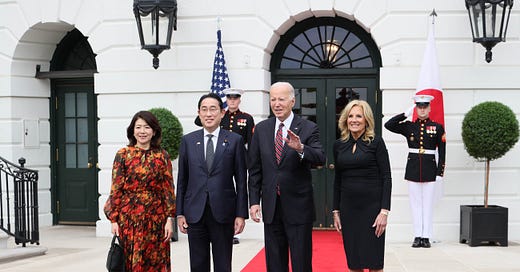Kishida boldly goes | This Week in Japanese Politics
The prime minister makes a splash in Washington, while at home the by-election field takes shape in Tokyo, the political reform fight ramps up, and Ueda hints at another change.
Prime Minister Kishida Fumio’s official visit to the United States dominated the news this week, so we’ll open with foreign and security policy. At home, Shizuoka Governor Kawakatsu Heita expedited his departure. Former Abe faction chairman Shionoya Ryū asked for a re-investigation of his punishment. The Liberal Democratic Party has no candidate in the Tokyo-15 by-election and could lose all three races. The yen continued to slide against the dollar, but Bank of Japan Governor Ueda Kazuo hinted at more policy changes to come. TSMC announces a new project in Kyushu. Plus: could another former prime minister make a comeback?
Foreign and security policy
Prime Minister Kishida’s official visit to the United States, the first since Abe Shinzō’s in 2015, is the single biggest political event of the week. Kishida’s trip included a meeting with CEOs at the US Chamber of Commerce; a press conference and meetings with US President Joe Biden at the White House, followed by the release of a lengthy joint statement; a state dinner; a speech before a joint meeting of Congress; and a visit to Toyota battery and HondaJet factories in North Carolina. (joint statement; fact sheet; press conference)
The joint statement’s language on China was more subdued than, say, the 2021 joint statement. It is noteworthy that the statement said, “In particular, we underscore the importance of candid communication with the PRC, including at the leader level, and express the intent to work with the PRC where possible on areas of common interest,” reflecting a mutual interest in high level coordination with Beijing. Nevertheless, the Chinese Ministry of Foreign Affairs issued protests against both the US-Japan summit and the US-Japan-Philippines summit.
The two governments announced several important initiatives to strengthen deterrence in the region. As reported, the US and Japan will begin consultations on coordination between an upgraded US operational command structure in Japan and the new Self-Defense Forces Joint Operational Command to improve allied interoperability. They will also coordinate to support Japan’s deployment of strike capabilities and launch new consultations on defense industrial cooperation that could enable Japanese facilities to maintain US warships and planes. Perhaps even more important are steps to integrate the US-Japan alliance with other alliances, referring to consultations to include Japan in AUKUS’s Pillar II; work with Australia to build a networked air defense system; and launched trilateral exercises with South Korea and the United Kingdom, the latter to begin in 2025. This set of relationships is being referred to as a “latticework” that moves beyond the postwar “hub-and-spokes” alliance system.
Keep reading with a 7-day free trial
Subscribe to Observing Japan to keep reading this post and get 7 days of free access to the full post archives.




